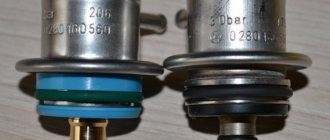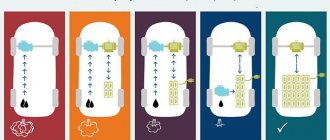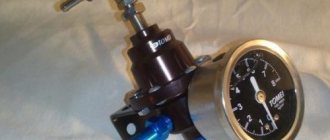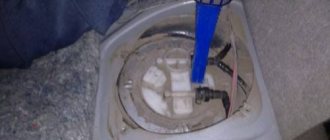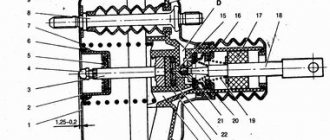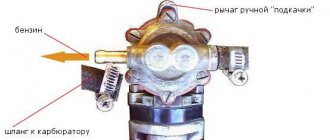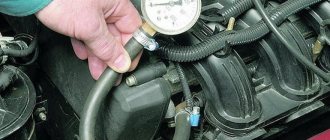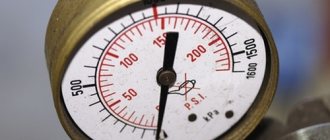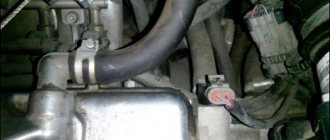Fuel pressure regulator - signs of malfunction
The control system of any modern engine with an injection system consists of a huge number of sensors that depend on one another, and together they report to the electronic control unit about the condition of the engine.
Based on this data, the ECU adjusts the main characteristics of fuel formation, the operation of the ignition system, right down to the operation of the transmission. And if one sensor or regulator gives incorrect readings, the engine will not work correctly. The fuel pressure regulator is also an important element for monitoring engine condition. Content:
VAZ 2107 engine injector device diagram
In the mid-90s, a massive transition of Russian models from a carburetor to an injection power system began. This requalification also affected the VAZ 2107 and 21074 cars. As a result, the model received new elements that structurally distinguish it from its predecessor:
- electric fuel pump. It takes fuel from the tank, maintaining constant pressure in the fuel line. The carburetor version had a mechanical fuel pump;
- fuel injectors that inject directly into the combustion chamber. Therefore, the fuel-air mixture is formed directly in the combustion chamber. On the previous modification, the mixture was formed due to the opening of the carburetor air damper;
- new engine control unit, which determines the moment of injection and forcibly performs it. The fuel mixture is forced into the cylinders by the injection system, while in the carburetor the fuel is supplied due to rarefied pressure after the valve opens.
Accordingly, the electrical circuit of the Lada has changed somewhat:
- a wiring harness block was added to the fuel frame;
- their wires were connected from the controller to the ignition system harness;
- radiator sensors and a fan appeared;
- the electric fuel pump was also connected to the circuit;
- The VAZ 21074 injector itself received sensors for mass air flow, oxygen indicator, crankshaft position, as well as a special valve in the line itself.
A VAZ with an injector type engine has fewer problems. Many electronic equipment control relays are quite reliable. However, the system is still not without its shortcomings. Some chargers are not friendly with the battery, the control unit for the electro-pneumatic valve sometimes malfunctions, and the light switch does not work when the front door is opened.
The electrical diagram of a VAZ 2107 with an injector will help you understand the description and repair. The following circuit is for models equipped with a 37.3701 generator.
Why do you need a fuel pressure regulator?
As mentioned above, this regulator maintains the required fuel pressure necessary for normal operation of the injectors, taking into account one or another operating mode of the power unit. In other words, the RTD affects the amount and intensity of the fuel supply that enters the engine cylinders through the injectors.
Simply put, the amount of fuel supplied to the engine at the time of injection depends on the pressure that is created inside the fuel rail (rail), as well as on the pulse duration for opening the injector and the vacuum in the intake manifold.
For more accurate dosing and maintaining constant pressure, a diaphragm valve-regulator is used, which experiences fuel pressure on one side, and a spring force on the other. RTD is used in power systems where there is a so-called “return”. The regulator is installed at the fuel rail. Also, this element can be located in the fuel tank, while such systems do not have a return line.
- Let's first look at the common design in which the regulator is located in the fuel rail. The element operates on the following principle: the fuel pump forces fuel from the fuel tank along the line. The resulting fuel pressure acts on the regulator. The device itself has two chambers (a spring chamber and a fuel chamber), which are separated by a membrane. On one side, the membrane is pressed by fuel, which enters the regulator through special inlet holes, and on the other side, there is spring pressure and intake manifold pressure. If the fuel pressure turns out to be stronger than the spring force and the pressure in the inlet, then the regulator opens slightly, resulting in some of the fuel being discharged into the return line. The fuel returns through the return line to the fuel tank.
- In systems without a return line, the regulator is usually located directly in the tank. The advantages include the absence of an additional pipeline. The injectors are supplied with the required amount of fuel directly from the tank, that is, excess fuel does not enter the engine compartment, and there is no need to deliver it back to the tank. This also allows us to talk about less heating of the fuel and provides a number of additional advantages in the form of less intense evaporation.
The fuel pump supplies the injectors with a strictly defined amount of fuel in relation to specific conditions and operating modes of the internal combustion engine. Let us add that in this system there is additionally an excess pressure relief valve, which helps to avoid its increase to a critical level.
Operating principle of RTD
The valve design and operating principle depend on the type of fuel system of a particular vehicle. There are 3 ways to supply gasoline from the tank to the injectors:
- The pump together with the regulator is installed inside the tank; fuel is supplied to the engine through one line.
- Gasoline is supplied through one tube and returned through another. The fuel system check valve is located on the distribution rail.
- The circuit without a mechanical regulator provides for electronic control of the fuel pump directly. The system contains a special sensor that registers pressure; the pump performance is regulated by the controller.
In the first case, the return flow is very short, since the valve and electric pump are interlocked into a single unit. The RTD, located immediately after the supercharger, dumps excess gasoline into the tank, and the required pressure is maintained throughout the supply line.
Reference. The first scheme with a regulator inside the gas tank has been implemented on all Russian-made VAZ cars.
The second option is used in most foreign cars. A valve built into the fuel rail allows excess fuel to flow into the return line leading to the tank. That is, 2 gasoline pipes are laid to the power unit.
There is no point in considering the third circuit - instead of a regulator, there is a sensor whose functionality is checked using a computer connected to the diagnostic connector.
A simple fuel pressure valve installed in the fuel pump unit consists of the following elements:
- cylindrical body with pipes for connecting the supply and return lines;
- a membrane connected to a locking rod;
- valve seat;
- spring.
The amount of pressure in the supply line depends on the elasticity of the spring . While most of the fuel goes into the cylinders (high load on the engine), it keeps the membrane and valve stem closed. When the crankshaft speed and gasoline consumption decrease, the pressure in the network increases, the spring compresses and the membrane opens the valve. The fuel begins to be discharged into the return line, and from there into the gas tank.
The fuel pressure regulator installed in the rail operates on a similar principle, but reacts faster to changes in load and gasoline consumption. This is facilitated by connecting an additional pipe of the element to the intake manifold. The higher the crankshaft speed and the vacuum on the spring side, the stronger the membrane presses the rod and closes the passage of fuel into the return line. When the load decreases and the speed drops, the vacuum decreases and the rod releases - the return flow opens and excess gasoline begins to be discharged into the tank.
How to check the fuel rail? Checking the RTD yourself
Checking the fuel pressure regulator is carried out to identify malfunctions or for prevention.
Such checks are carried out based on the recommendations of the car manufacturer. But still, how to check the pressure in the fuel rail? Basically, the check consists of inspecting and checking the pressure of the fuel system at various engine speeds. Then comparisons are made with indicators that correspond to the norm. It is necessary to carefully inspect the tightness of the connections, the condition of the vacuum hose, as well as the regulator itself. If no damage or defects are found, then the regulator is dismantled by completely disassembling it. If a blockage is detected in this unit, it is washed.
Important: the pressure in the fuel rail should be diagnosed using a pressure gauge. It is connected to a special diagnostic fitting.
How to check the fuel pressure regulator. Fuel pressure regulator diagnostics
You can also check the regulator yourself. To do this, you do not need to use any special tools or have any special auto mechanic skills. You will need to pinch or disconnect the valve and observe the force of the jet. Or for a better check, use a pressure gauge.
To measure the RTD pressure in the engine when turning on idle speed, it is worth connecting a pressure gauge, installing it between the fuel hose and the fitting. Don't forget to disconnect the vacuum hose. Below we will look at what pressure should be in the fuel rail of a VAZ 2110.
When measuring the pressure in the fuel rail with your own hands, the pressure should begin to increase from
0.3 to as much as 0.7 Bar.
If the pressure remains in place, repeat the procedure. It happens that after a number of necessary procedures, the pressure remains the same. This means that the regulator is faulty and cannot be repaired. It needs to be replaced.
How do malfunctions of the fuel pressure regulator affect engine performance?
A faulty regulator valve affects not only operation, but also the very start of the engine.
If the device is working properly, the pressure in the fuel rail does not drop after the engine stops. If the valve has a malfunction, then the pressure in the fuel rail drops when the engine stops. The engine will not start until the sediment has completely filled the system. And only after reaching the desired level, the first engine start signals may appear. Here everything will depend on the power of the battery. Otherwise, the engine will not be able to start. Therefore, if the pressure in the fuel rail does not hold, this indicates a malfunction! In addition to the above, gas failures may occur during acceleration of the car, unstable idling, and a general weakening of engine power will begin to appear.
VAZ 2105 injector - Repair and operation
- VAZ 2105 injector Review (interior, exterior). Drift VAZ 2105 stock injector. Photo. Review (interior, exterior, engine). Overview (interior, exterior). The car was built in Spartan conditions, engine 1.6 injector 8 valves receiver turbo theme spider 4.2.1 welded differential 4.1. Tuning for the VAZ 2105 carburetor, when installed, also requires detailed instructions, or better yet some kind of diagram for proper installation and maintenance. VAZ 2105 is a carburetor, the diagram of which is represented by 13 parts. The technical characteristics of the injector 21053 are best presented in a similar diagram, thanks to which the injector 21053 will become clear in
Tuning the VAZ 2107 engine with injector yourself
Refinement of the cylinder head of a VAZ 8kl. VAZ 2107 engine tuning tests. Photo. Refinement of the cylinder head of a VAZ 8kl. 2108,2109,2110,2114, viburnum, grant. Tuning and increasing engine power. Refinement of the cylinder head of a VAZ 8kl. auto, Opel, Honda, Renault, Audi, Toyota, Peugeot. The VAZ 2107 was created on the basis of the VAZ 2105 prototype, because it had proven itself very well in the domestic market at one time. VAZ 2107 engine tuning tests. What is an injector and what is the operating principle of the injection system? You will learn this and much more in the section of our portal.
Wiring diagram VAZ 2107 injector
VAZ 2107.21047 wiring diagram + repair manual. Posting 2105 start. Photo. Wiring diagram VAZ 2107,21047+repair manual. VAZ 2107.21047 wiring diagram + repair manual. I'm starting to assemble the wiring for the 2105, the panel and the relay and fuse box. 1 – radiator fan drive motor; 2 – relay and fuse block (mounting block); idle speed sensor; 4 – engine control unit; 5 – potentiometer; 6 – set of spark plugs; 7 – ignition control unit; 8 – electronic crankshaft sensor; 9 – electric fuel pump; 10 – tachometer; 11 – lamp
Adjusting valves on VAZ 2107 injector
Adjustment of valves. Adjusting valves VAZ Classic! Photo. It is described in detail and shown how to adjust the valves on a VAZ. Adjustment of valves. Adjusting VAZ 2101,2102,2103,2104,2105,2106,2107 valves at home without special tools! It should be taken into account that twisting the crankshaft does not provide for its return. The circle will need to be scrolled again. Adjusting valves VAZ Classic! What is an injector and what is the operating principle of this device? You will learn this and much more in the section of our portal. In this video section you will find video materials devoted to the principles of operation and design of an auto injector, and everything related to it.
No pressure in the fuel rail, reasons
The presence of a certain pressure in the fuel rail of an injection engine is one of the conditions for its operation.
Using the example of the fuel rail of the fuel injection system 2111 of the VAZ 21093 (21083, 21099) car, we will consider the signs and reasons for the disappearance or decrease in gasoline pressure in it.
Signs that there is no pressure in the fuel rail
Car engine does not start
The starter turns, but there are no or infrequent sparks in the cylinders.
The car engine starts and immediately stalls
After starting, the engine makes a few revolutions and stalls.
Unstable engine speed at idle
The engine jerks, shakes, and tries to stall when idling.
Dips, jerking and jerking after pressing the gas pedal
When pressing the gas pedal, instead of the expected increase in speed and pickup while the car is moving, the driver feels that the engine is trying to stop and stall - failure or several such attempts extended over time - jerking and jerking.
Reduced power and throttle response of a car engine
The car's former agility and engine traction have disappeared somewhere; the car can barely pull.
Causes of the “no pressure in the fuel rail” fault
Fuel pump faulty
The electric fuel pump cannot create the required pressure in the fuel system due to its malfunction or a malfunction of the electrical switching circuit. If the pump fails completely, then there can be no question of any pressure in the fuel rail.
Fuel filter clogged
When the fuel filter of the fuel injection system becomes clogged, its throughput decreases (in some cases it disappears altogether). As a result, gasoline cannot be pumped into the fuel rail by the gasoline pump with sufficient pressure, or maintaining the required pressure at different engine operating modes becomes impossible. See “Signs of a clogged fuel filter in the fuel injection system.”
Additional designations
The fuses of the VAZ 2107 car are located as follows:
- taillights and reversing lights;
- electric motor of the heater fan, headlight washer and glass wiper pumps;
- indicator for turning on the rear window heater VAZ 2107;
- direction indicators and hazard warning relays;
- fog lights;
- tachometer, voltmeter;
- control lamps for oil pressure, fluid, fuel level and reserve indicators on the instrument panel, instrument panel lighting;
- cigarette lighter and clock;
- VAZ sound signal;
- interior lighting (up to 2000 there was one lamp on the ceiling, for those manufactured after 2000 there were two lamps on the rear door pillars);
- high beam headlights;
- high beam warning lamp;
- engine compartment lighting and license plate lighting;
- glove compartment lighting;
- right headlight;
- left headlight.
A detailed wiring diagram of the VAZ 2107 will help you understand the intricacy of electrical wiring elements, find the air cover switch or the windshield and headlight wiper relay.
PROMOTION: SALE OF NEW CAR 2021 PRODUCTION
“Seven” is the latest representative of the VAZ series of rear-wheel drive cars. The seventh model was developed on the basis of the VAZ 2105 and differs in the shape of the seats, interior trim, shape of lighting devices and engine power.
Initially, the VAZ 2107 was equipped with a one and a half liter engine from the VAZ 2103. Subsequently, the range of engines installed on the “seven” was expanded. Cars with engine sizes ranging from 1.45 to 1.7 liters were produced for different markets. It was the 1.7 liter engine that was the first to be equipped not with a carburetor, but with an injection power system. Subsequently, the VAZ 2107 injector completely removed carburetor cars from the assembly line.
Device
The VAZ 2107 injector consists of the following elements:
- Computer;
- Sensors;
- Fuel pipes and hoses;
- Fuel and air filter;
- Actuators;
- Gas tank;
- Wiring.
The injector power system contains the main element - a computer or ECU. Its permanent memory contains a program (algorithm) in accordance with which the control of actuators is implemented, these include:
- Fuel pump;
- Injectors;
- Idle air control;
- Canister valve.
Each of the above elements performs its own function.
Gasoline pump
Turned on by the ECU output signal through a relay. Has a strainer and fuel level sensor. The gasoline from it passes through the fuel filter. The pump is located in the tank and to remove it, you need to remove the back seat, remove the hatch and unscrew the fastener.
Nozzle
It is a sprayer equipped with a solenoid valve. Triggered by an ECU impulse. Accordingly, the duration of valve opening (the amount of gasoline supplied) depends on the time the pulse is applied. It is installed on a ramp common to all injectors, a constant pressure in which is maintained by a valve. If it is exceeded, the valve opens and gasoline returns back to the tank. The injector enters the intake manifold. The air flow, passing through the intake manifold, carries away a portion of gasoline ejected by the nozzle.
The structure of the VAZ 2107 fuel system
Idle speed control
The fuel system maintains engine idle speed using a regulator. It is a stepper motor connected to a conical shaped control body. Its approach reduces the air flow entering the intake manifold; its removal, on the contrary, increases it.
Canister valve
It is needed to turn on the ventilation of the adsorber, which accumulates gasoline vapors and releases them into the intake manifold at the right moment.
The injector power system contains sensors for measuring, converting and transmitting the signal to the computer.
The following sensors are installed on the VAZ 2107:
- Crankshaft position;
- Mass air flow;
- Throttle position;
- Coolant temperature;
- Speed;
- Oxygen content in exhaust gases.
Design and features of the VAZ 2107 injector
General view of the engine compartment of the VAZ 2107. It is immediately clear that there is no distributor and carburetor.
The VAZ 2107 was not always “injected”. For many years the engine was carburetor. Only since 2006, for the production of VAZ for the domestic Russian market, the engine acquired a forced fuel injection system. The meaning of those innovations was simple - compliance with already accepted Euro 2 standards, which European cars have complied with for many years. The total power of the unit with the new power system was 50 kilowatts. The characteristics of the engine with the new fuel injection were as follows:
- The mode of consumption in the city is 8.5 liters\100 km;
- Fuel consumption at a speed of 90 km/h – 6.9 – 7.0 liters/100 km;
- Consumption at a speed of 120 km/h is about 9.1 liters.
The plant guaranteed these characteristics for the VAZ 2107 injector when using gasoline type A - 95. No other type of gasoline was provided for the calculations. The point of converting from carburetor injection to electronic injection was that constant adjustment and fine-tuning of the injection was not required, as with an injection engine. The device is such that the idle speed indicators do not “float”.
The device shown is a control unit, “microprocessor brains.”
The block takes into account the indicators of those sensors that are necessary for the normal operation of injection injection, namely:
- Throttle position sensor - the device is a resistor of variable capacity, which depends on the degree of pressing the gas pedal. There is no similar equipment in Zhiguli cars, but there is plenty of radio receivers.
- Crankshaft position sensor (that is, cylinder operation). According to the readings of this sensor, the operation of the electronic processor is completely synchronized with the crankshaft speed. This is the "reference clock speed".
- An indicator of the saturation of a mixture with oxygen. This device is located on the exhaust gas pipe, and uses feedback to control the amount of incoming fuel in the mixture, since fuel, when burned, consumes oxygen. The indicators of those processes are completely interrelated. In the figure, the exhaust pipe and sensor are connected by a weld, which means that the exhaust system has most likely been repaired.
- MAF (mass air flow sensor). It is mounted on the “air” body. Its task is to accurately determine the amount of air that enters the intake manifold, and therefore the characteristics of the combustion mixture.
The sensors described above relate exclusively to the injection system, and they are not available on carburetor versions of the “seven”.
Naturally, “there is no smoke without fire.” Therefore, along with many advantages, VAZ 2107 equipped with fuel injection also has certain “cons”.
Disadvantages of an injection engine;
- High requirements for fuel quality and octane number;
- The catalyst installed “under the bottom” of the car significantly reduces the ground clearance, depriving the “Seven” of some off-road advantages over the “puzoterki”;
- More complex engine repairs and difficult access to engine compartment parts.
- In order to find a malfunction in the injection system, special instruments are needed;
- In general, the “injector” is more capricious. So, for example, the opportunity to light a cigarette for a friend may result in the engine stalling. The reason is a malfunction of the “electronic brains”.
But the advantages completely compensate for these disadvantages, since injection injection allows you to save fuel, makes cold starting of the engine easier, and there is no need to “tinker” with the carburetor. A car with such an injection will serve you for many years with proper care.
Source
Withdrawal procedure
- The first step is to remove the fuel module.
- Then you need to lift the fuel module cover and disconnect the wire from the fuel pressure regulator.
Using a screwdriver, pry up and remove the spring clamp of the pressure regulator.
We take the regulator out of the cover.
Installation locations
On cars, the injection system is equipped with a separate line for draining excess gasoline, which goes from the fuel rail to the gas tank (fuel recirculation). In such injectors, the regulator is installed directly on the fuel rail (or connected to it), so the unit quickly “reacts” to changes in engine operating conditions and adjusts the pressure in the rail. In this design of the power system, a mechanical type RTD is used.
There is another version of the injector - without gasoline recirculation. In this system there is no “return” at all, and regulation is carried out at the output of their fuel pump. A feature of such a system is the location of the regulator - in the tank or near it. An RTD is already used here, the operation of which is controlled by the ECU - the control unit, through a sensor installed in the ramp, monitors the necessary parameters and corrects them by sending signals to the regulator.
Power systems with electronic regulators are used less frequently than mechanical ones due to their complex design and, accordingly, lower reliability.
How to find a fault
You need to look for the cause of a fuel system malfunction in two directions: electrical and mechanical. The first option is diagnostics of sensors and their electrical circuits. The second is to check the pressure in the system, which will show how the fuel pump works and how gasoline flows to the injectors.
Error codes
It is recommended to start searching for any breakdown in an injection car by reading the error code issued by the electronic control unit, because most of the listed power system faults will be accompanied by a “CHECK” light on the dashboard. To do this, you can contact a service station, or carry out diagnostics yourself if you have a scanner designed for this. The table below shows error codes in the operation of the VAZ 2107 fuel system with their interpretation.
Table: error codes and their meaning
Checking the rail pressure
As mentioned above, the operating pressure in the power system of the injection “seven” should be 2.8–3.2 bar. You can check whether it corresponds to these values using a special liquid pressure gauge. The device is connected to a fitting located on the fuel rail. Measurements are taken with the ignition on without starting the engine and with the power unit running. If the pressure is less than normal, the problem should be looked for in the fuel pump or fuel filter. It is also worth inspecting the fuel line pipes. They may be damaged or pinched.
A special liquid pressure gauge is used to check the pressure
Characteristic symptoms of fuel pressure regulator malfunctions
By what signs can you determine that an RDT is not working:
- the engine is very difficult to start, you need to turn the starter for a long time and at the same time keep the gas pedal pressed in order for the engine to start;
- The engine idles unsteadily or the speed is very low, the engine often stalls. At the same time, it does not gain power at all; when trying to accelerate, it results in a deep failure;
- The spam engine changes speed sharply, this is especially noticeable at idle:
- Fuel is leaking from the fuel hoses. Attempts to tighten and replace clamps and replace hoses do not help.
Malfunctions of the VAZ 2107 injection engine
Problems with the 7 injection engine usually manifest themselves as follows:
- The engine is running erratically.
- Fuel consumption of the VAZ 2107 has been increased.
- There is an increased CO content in the exhaust gases.
- Dips when pressing the accelerator pedal.
- The engine “does not pull” (reduced power).
- To diagnose injection system faults, special equipment is required. In particular, in order to read error codes and check sensor readings and the operation of the engine ECU, a special computer (tester) is required. Therefore, repairs and diagnostics of the VAZ 2107 injector are carried out at specialized service stations. The most common cause of injector failure is clogged injectors.
